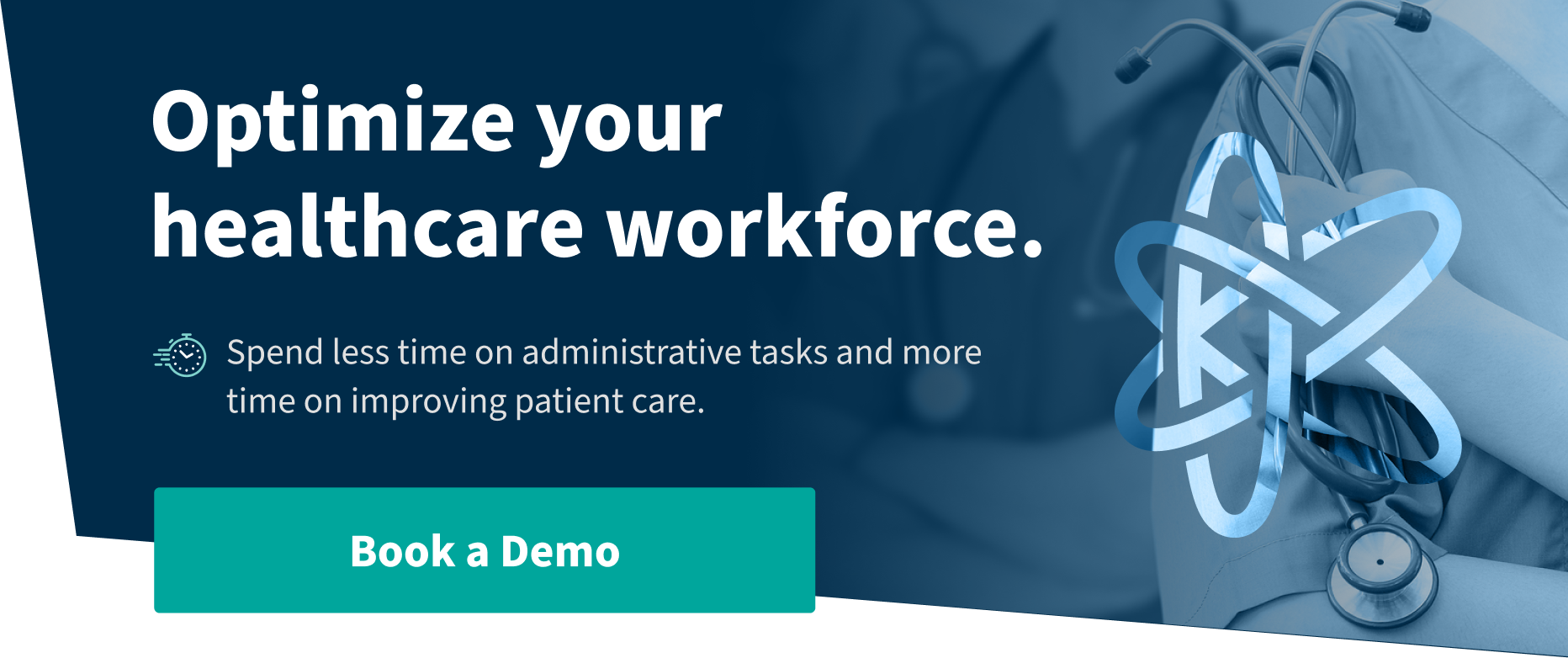When your employed, contract, and contingent clinicians aren't strategically deployed, the ripple effects touch everything from operational costs to organizational growth. Yet managing this allocation effectively has become increasingly challenging.
Healthcare organizations face significant revenue loss through inefficient clinician management. From expired credentials causing compliance issues to double-booked clinicians leaving critical shifts uncovered, the financial impact is substantial. Whereas organizations using integrated workforce management are able to reduce their contingent labor premium costs by 33% (from 1.8x to 1.2x W2 vs locum premium).
For organizations managing 20-100 clinicians across multiple locations, staffing inefficiencies are operational headaches as well as barriers to strategic growth.
Let's dive into the innovative ways operations leaders are revolutionizing clinician allocation using integrated systems, real-time analytics, and automated workflows to manage their clinical staff. We'll explore practical strategies that optimize your workforce while cutting through administrative complexity and ensuring accurate compensation.
The Strategic Value of Efficient Clinician Allocation
For healthcare operations leaders, efficient clinician allocation is more than a scheduling exercise—it's a strategic imperative that directly impacts financial performance and organizational growth. Strategic allocation of your clinician workforce delivers measurable value across multiple operational dimensions:
Financial Control
- Reduce reliance on expensive contingent coverage by optimizing your employed and contract clinician utilization
- Minimize unnecessary overtime costs through predictive scheduling and real-time analytics
- Lower administrative overhead by automating credential tracking and schedule management
Operational Excellence
- Match clinician credentials and specialties to service demands across departments
- Enable flexible coverage models that adapt to changing patient volumes
- Streamline handoffs and care transitions through aligned scheduling
- Transform your float-pool into a strategic asset for dynamic coverage
Risk Mitigation
- Ensure all shifts are covered by appropriately credentialed clinicians
- Maintain compliance with regulatory requirements through automated tracking
- Reduce potential gaps in coverage that could impact care delivery
When operations leaders implement strategic clinician allocation, the benefits cascade throughout the organization. Real-time analytics provide visibility into utilization patterns, enabling data-driven decisions about workforce deployment. Automated workflow tools reduce administrative burdens—freeing your team to focus on strategic initiatives.
As a result, organizations typically see:
- 20-30% reduction in contingent staffing costs
- Improved clinician satisfaction through optimized schedules and reduced administrative burden
- Enhanced operational efficiency with streamlined workflows and automated processes
- Better resource utilization across departments and locations
These improvements create a foundation for sustainable growth while ensuring your organization maintains the agility to respond to changing demands in today's dynamic healthcare environment.
Why is Clinician Allocation So Challenging?
Managing clinician schedules might seem straightforward on the surface—matching the right clinicians to the right shifts. Yet healthcare operations leaders know the reality is far more complex. Here's why coordinating clinicians across your organization has become one of healthcare's most pressing operational challenges.
Unpredictable Demands
Healthcare doesn't follow a neat 9-to-5 schedule. Patient volumes surge and dip unpredictably, forcing operations leaders to constantly adjust clinician coverage. When the emergency department suddenly needs extra support or the surgery schedule runs long, the domino effect ripples through the entire organization.
Credential Complexity
Every clinician brings a unique mix of credentials, privileges, and specialties. Operations leaders must track expiration dates, maintain compliance, and ensure each shift is covered by appropriately qualified clinicians. With employed, contract, and contingent clinicians in the mix, keeping track becomes a full-time job on its own.
Department Balancing Act
Moving clinicians between departments isn't as simple as filling an empty slot. Each adjustment requires careful consideration of credentials, compensation rates, and coverage impacts on other areas. Without clear visibility into these factors, operations leaders often overspend on temporary coverage to fill gaps.
Financial Oversight
Beyond the obvious costs of overtime and temporary staffing, poor allocation creates hidden expenses. Administrative overhead builds up. Schedule gaps lead to lost revenue. Variable compensation rates for different clinician types make accurate payment tracking a constant challenge. For growing organizations, these costs compound with each new location or service line.
The Scale Challenge
For growing healthcare organizations, these challenges intensify with scale. Each new location or service line multiplies the complexity of credential tracking, schedule coordination, and financial oversight. Without integrated systems and automated workflows, operations leaders find themselves trapped in a cycle of reactive management rather than strategic growth.
Three Essential Strategies for Effective Clinician Allocation
Modern healthcare operations demand sophisticated approaches to clinician allocation. Here are three proven strategies that operations leaders use to optimize their clinician workforce while maintaining operational efficiency and cost control.
1. Leverage Data-Driven Decision Making
Gone are the days of intuition-based scheduling. Today's operations leaders rely on historical data and predictive analytics to make informed allocation decisions. By analyzing past patient volumes, seasonal trends, and department-specific patterns, you can anticipate staffing needs with greater accuracy. This approach helps match clinician coverage to expected demand while maintaining regulatory compliance and cost efficiency.
For growing organizations, data insights become particularly valuable when allocating specialized clinicians across multiple locations. Understanding utilization patterns helps optimize your float pool deployment and reduce reliance on expensive contingent coverage.
2. Enable Dynamic Schedule Management
Healthcare demands change rapidly. Your allocation strategy must be equally responsive. Modern operations leaders are moving away from rigid scheduling systems toward flexible approaches that accommodate real-time adjustments. This means building buffer capacity into schedules, enabling quick responses to volume changes, and facilitating seamless coordination between departments.
The key is giving clinicians and department leaders the tools to collaborate on coverage solutions. When an emergency department faces an unexpected surge, the ability to quickly identify and deploy qualified clinicians from other areas can prevent costly reliance on temporary staff.
3. Maintain Credential-Driven Coverage
Effective clinician allocation requires more than matching numbers—it demands the right credentials for each shift. Operations leaders must ensure every schedule change maintains compliance while optimizing skill mix across departments. This means tracking multiple credentials, privileges, and specialties while coordinating coverage across employed, contract, and contingent clinicians.
Success requires establishing clear protocols for cross-department coverage, maintaining up-to-date credential tracking, and ensuring your float pool has the right mix of qualifications to provide flexible support. When done right, this approach creates operational resilience while controlling costs.
Technology as an Enabler
While these strategies set the foundation, their execution depends on having the right tools. Modern operations leaders are moving away from spreadsheets and fragmented systems toward integrated platforms that unify scheduling, credentialing, and financial oversight. This technology shift enables real-time visibility into clinician availability, automated credential tracking, and dynamic schedule adjustments—transforming how organizations approach clinician allocation.
By implementing these strategies with the right technological support, operations leaders can create more efficient, responsive, and cost-effective clinician allocation models. The result is an organization better positioned to handle today's healthcare challenges while building capacity for future growth.
Transform Your Clinician Allocation with Kimedics
Healthcare operations leaders need more than just another scheduling tool.
Kimedics delivers an integrated platform specifically designed to solve the complex challenges of modern clinician allocation:
- Real-time analytics for proactive coverage planning
- Automated credential tracking and expiration alerts
- Float pool optimization across departments
- Integrated rate management for all clinician types
- Mobile access for quick schedule adjustments
- Cross-department coordination tools
- Unified view of scheduling, credentials, and compensation
Whether you're managing a growing practice or a division of a larger health system, Kimedics transforms clinician allocation from an administrative burden into a strategic advantage. It'll help you reduce costs, improve clinician satisfaction, and provide the operational efficiency needed to drive organizational growth.
Schedule a 10-minute consultation with our team to learn how we can transform your clinician allocation challenges into operational advantages.


